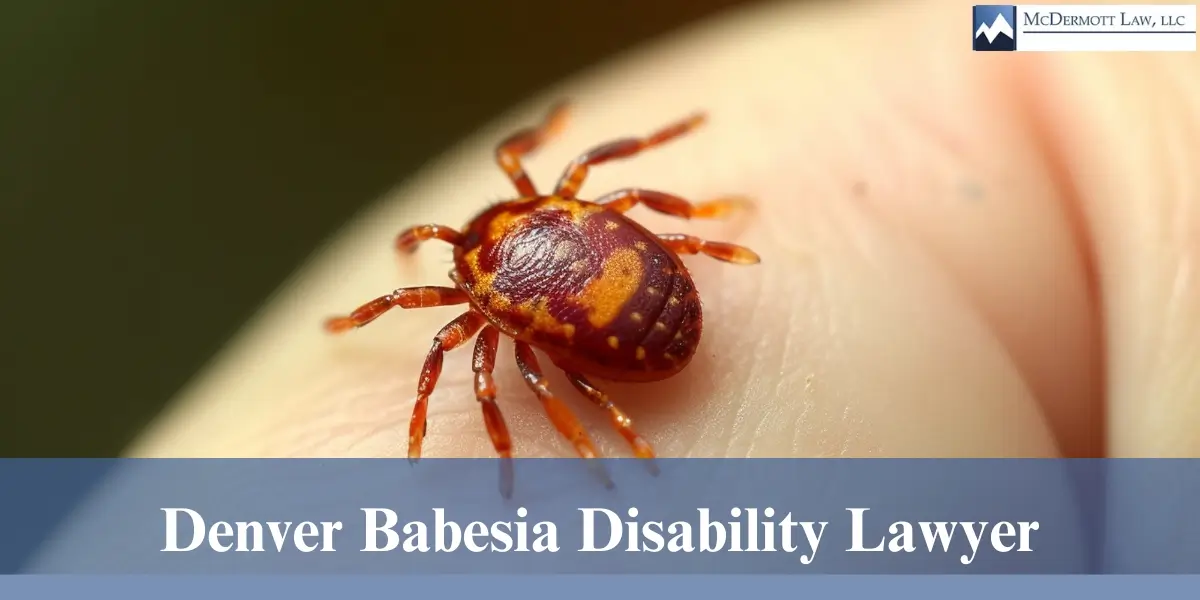Denver Babesia Disability Lawyer
Denver Babesia Disability Attorney
Babesia is a co-infection of Lyme disease caused by a malaria-like parasite, called a piroplasm, that infects red blood cells. Ticks sometimes only carry Babesia, or they may carry both Babesia and Lyme. Symptoms of Babesia infection include high fever, chills, fatigue, headache, sweats, muscle aches, nausea, and vomiting. Diagnosis can be made by examining blood smears under a microscope, but this method is only reliable during the first two weeks of infection. If you’re dealing with Babesia and need assistance with disability claims, our expert lawyers team at McDermott Law, LLC is here to help. Meet our skilled Denver Babesia disability attorneys at McDermott Law, LLC, who can guide you through the process and help you navigate your legal options.

Bartonella
Bartonella is a co-infection of Lyme Disease that is a bacteria known to be carried by fleas, body lice, and ticks. Symptoms include fatigue, fever, headaches, poor appetite, and an unusual, streaked rash. One usually sees swollen glands around the head, neck, and arms. Diagnosis can be made using polymerase chain reaction and tissue biopsy, however they are not always reliable.
Borreliosis (Lyme Disease)
Lyme disease is caused by the bacterium Borrelia burgdorferi, and is transmitted to humans through the bite of an infected blacklegged deer tick. It is the most common tick-borne infectious disease in the United States. Untreated Lyme disease can produce a wide range of symptoms, depending on the stage of infection. Typical symptoms include fever, chills, headache, fatigue, muscle and joint aches, swollen lymph nodes, and a rash. Most cases of Lyme disease can be treated successfully with a few weeks of antibiotics. If left untreated, infection can spread to joints, the heart, and the nervous system; causing facial paralysis, severe arthritis, heart palpitations, and inflammation of the brain and spinal cord.
Lyme Disease. Centers for Disease Control (updated January 19, 2018), https://www.cdc.gov/lyme/index.html
Clostridium difficile (C. difficile)
Clostridium difficile (C. difficile) is a bacterium that can cause severe diarrhea to life-threatening inflammation of the colon. It usually affects people who have recently been in health care facilities or been on antibiotics. Symptoms include watery diarrhea, abdominal pain, fever, bloody stools, nausea, dehydration, loss of appetite, weight loss, swollen abdomen, kidney failure, and increased white blood cell count.
Ehrlichia
Ehrlichia is a co-infection of Lyme Disease which infects different kinds of white blood cells. In HME (human monocytic ehrlichiosis), they infect monocytes. In HGE (human granulocytic ehrlichiosis), they infect granulocytes. Symptoms include sudden high fever, fatigue, muscle aches, and headache. Severely ill patients can have low white blood cell count, low platelet count, anemia, elevated liver enzymes, kidney failure, and respiratory insufficiency. Diagnosis is limited by the ability to test for only two species of bacteria. Ehrlichia parasites multiple inside host cells, forming large mulberry-shaped clusters called morulae which are sometimes seen on blood smears, but are often missed. Doctors may suspect ehrlichiosis/anaplasmosis in a patient who does not respond well to treatment for Lyme Disease
Leptospirosis
Leptospirosis is a rare and severe bacterial infection that occurs when people are exposed to water and soil that has been contaminated by infected animal urine and usually occurs in warmer climates. Symptoms may include dry cough, fever, headache, muscle pain, nausea, vomiting, diarrhea, and shaking chills. Less common symptoms include abdominal pain, abnormal lung sounds, bone pain, conjunctivitis, enlarged lymph glands, enlarged spleen or liver, joint aches, muscle rigidity, muscle tenderness, skin rash, and sore throat. Complications can include meningitis, kidney damage, liver failure, respiratory distress and even death.
Leptospirosis. Centers for Disease Control (updated October 30, 2017), https://www.cdc.gov/leptospirosis/index.html
Meningitis
Meningitis is an infection of the membranes covering the brain and the spinal cord (meninges). The most common causes of meningitis are viral infections, which tend to get better without treatment. However, bacterial meningitis infections are extremely serious, and may result in death or brain damage, even if treated. Meningitis can be caused by chemical irritation, drug allergies, fungi, or tumors. Symptoms can include fever and chills, mental status changes, nausea and vomiting, sensitivity to light (photophobia), severe headache, stiff neck, agitation, bulging fontanelles, decreased consciousness, rapid breathing, or unusual posture with the head and neck arched backwards. Complications from meningitis can include brain damage, buildup of fluid between the skull and brain, hearing loss, hydrocephalus, and seizures.
Meningitis. PubMed Health (May 22, 2018)
Mycobacterium avium complex (MAC)
Mycobacterium avium complex (MAC) is a pulmonary pathogen affecting patients with suppressed immune systems. MAC is made up of two species: M avium and M intracellulare – collectively called Mycobacterium avium-intracellulare (MAI). It has been associated with osteomyelitis, tenosynovitis, synovitis, and other diseases involving the lymph nodes, central nervous system, liver, spleen, and bone marrow
https://emedicine.medscape.com/article/222664-overview
Contact Us
For more information about your legal rights and entitlements, along with a professional evaluation of your potential case, set up a free Review of Denied Claims by calling us at 303-964-1800, or complete our contact form. We offer free Review of Denied Claims and represent clients throughout the Denver area and the Rocky Mountain region.
Get A Free Case Evaluation of Your Denied Claim
Fields Marked With An “*” Are Required



